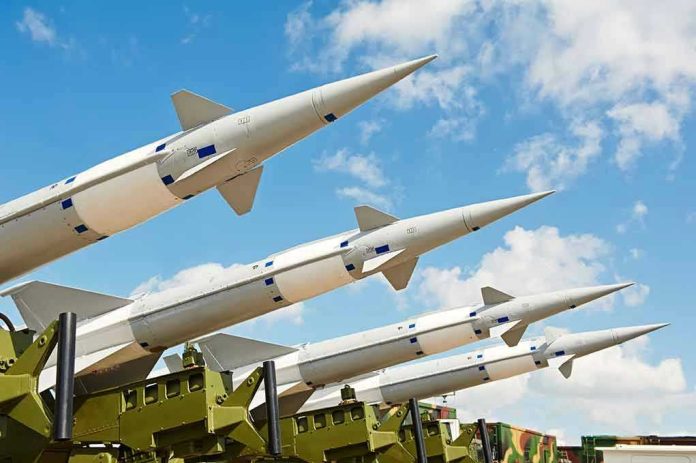
America’s missile stockpiles have been run dangerously low, and the Pentagon is now scrambling to quadruple production rates—sparking urgent debate about whether the U.S. industrial base can keep up as China’s military threat grows.
Story Snapshot
- The Pentagon is demanding U.S. defense contractors massively increase missile production amid fears of a potential conflict with China.
- Missile stockpiles are depleted after years of supplying Ukraine and Israel, leaving the U.S. at just 25% of needed Patriot missiles.
- Ambitious Pentagon goals—up to 4x current output—face skepticism from industry leaders, who warn of manufacturing and funding bottlenecks.
- President Trump’s administration is weighing extraordinary measures to restore military readiness and safeguard American security.
Pentagon Sounds Alarm Over Missile Shortages and China’s Rapid Buildup
The Pentagon has issued an urgent call to America’s top defense contractors, demanding plans to double or even quadruple output of twelve critical missile systems, including the Patriot air defense missile and long-range anti-ship missiles. This dramatic surge comes after months of alarm over China’s rapidly advancing military and the dangerously low state of U.S. missile reserves—depleted by years of sending weapons to Ukraine and Israel. As of this month, the U.S. is believed to have only a quarter of the Patriot missiles it needs to deter a major adversary.
In June, Pentagon officials convened with weapons makers, ordering them to submit plans for boosting production by 2.5 times within two years. By September, the Army had awarded Lockheed Martin a nearly $10 billion contract to deliver roughly 2,000 PAC-3 missiles by 2026—a contract of historic scale. Yet industry leaders have voiced doubts about whether the nation’s manufacturing capacity is up to the task, given ongoing labor shortages, supply chain snags, and the sheer speed of the ramp-up demanded by federal officials.
U.S. Defense Industry Faces Unprecedented Pressure and Funding Hurdles
America’s defense industrial base is under more strain than at any time since the Cold War. While the Pentagon holds the power to award contracts and set requirements, it relies on industry’s willingness to invest in expanded facilities and new workers. Contractors such as Lockheed Martin and Raytheon have responded by increasing inventories and exploring plant expansions, but they are insisting on solid government funding commitments before making risky, large-scale investments. Pentagon leaders, including Deputy Secretary of War Stephen Feinberg, are meeting weekly with industry executives to manage the crisis, but both sides acknowledge that ramping up to four times current production rates could take years even with full cooperation.
Experts warn that unless Congress backs up Pentagon ambitions with guaranteed funding and regulatory streamlining, the effort could stall—leaving U.S. forces and allies vulnerable. The Trump administration, with President Trump and Secretary Pete Hegseth at the helm, is reportedly considering extraordinary measures to accelerate production and restore American military advantage. This includes exploring additional executive powers and emergency procurement authorities, echoing the kind of “all hands on deck” approach not seen since World War II.
Global Arms Demand and Geopolitical Risks Intensify
The Pentagon’s move is reverberating far beyond Washington, as nations across the globe race to acquire advanced missile systems. U.S. allies in Europe and Asia are clamoring for more Patriot batteries, with no European alternative available, which puts even greater pressure on American manufacturers. Meanwhile, China’s military modernization—including rapid missile and nuclear arsenal expansion—is fueling an arms race that could reshape global security for years to come. Defense analysts caution that the U.S. is not just replenishing depleted stocks, but also fighting to maintain its role as the world’s arsenal for freedom-loving nations.
Some industry and academic experts, such as Professor Shen Yi of Fudan University, have called the Pentagon’s production targets “unrealistic,” highlighting deep-seated problems in U.S. manufacturing flexibility and capacity. Still, others argue that a credible surge in missile output is essential for deterrence—and that failing to act now could embolden China at a critical moment. The stakes are high, not only for military readiness but for America’s economic and technological leadership on the world stage.
Industrial Bottlenecks, Workforce Shortages, and the Path Ahead
With billions of dollars in new contracts on the line, the U.S. defense sector could see a surge in job growth and innovation—if it can overcome significant hurdles. Manufacturing bottlenecks, a shortage of skilled labor, and global supply chain disruptions threaten to delay progress. The Pentagon’s own estimates suggest missile stockpiles will remain below required levels for months, if not years, unless the industrial base receives sustained investment and regulatory relief. The Trump administration’s push for “America First” defense policies is being tested by the realities of a system hollowed out by decades of outsourcing and underinvestment.
Pentagon urges suppliers to massively boost missile production amid China war fears https://t.co/ROa71eg00Q
— BPR (@BIZPACReview) September 30, 2025
Americans who value national security, military strength, and constitutional principles should keep a close eye on how Congress and the Pentagon respond in the coming months. The battle to rebuild U.S. missile capacity is more than a budget fight—it is a test of whether the nation can still rise to meet new threats and defend our way of life against hostile powers and failed globalist policies of the past.
Sources:
Pentagon Urges Suppliers To Massively Boost Missile Production Amid China War Fears
U.S. to Increase Missile Production for Possible Conflict with China














